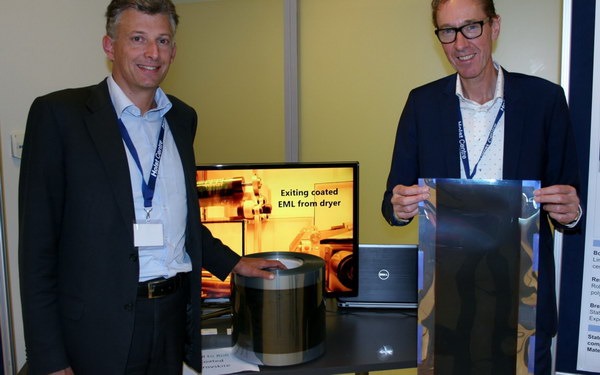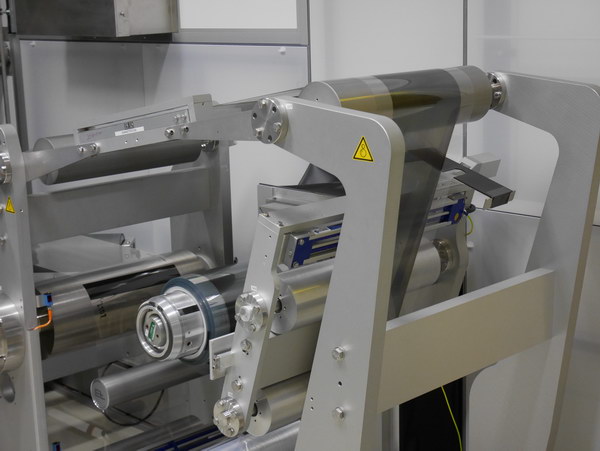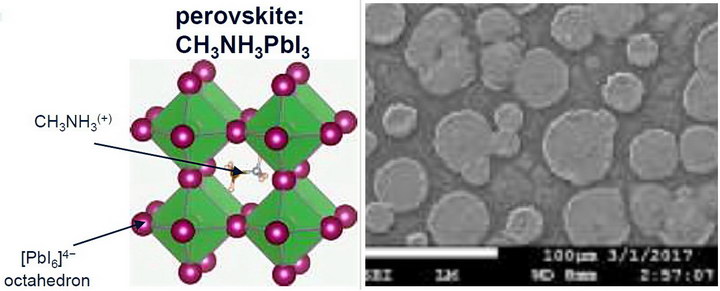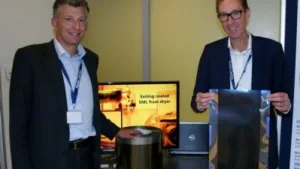A research group in the Netherlands has has announced the development of roll-to-roll (R2R) processing of perovskites for solar cells. This system has produced solar cells with an efficiency of 12.6%, a record for the R2R processing of solar cells and there are implications for display manufacturing.

Solliance Solar Research is a research partnership dedicated to improving solar cells. It is headquartered at the High Tech Campus in Eindhoven, the Netherlands, co-located with the Holst Centre. The research organization is a joint venture of ECN, TNO, Holst Centre and imec, with academic partners from TU Eindhoven, University of Hasselt, TU Delft and Forschungszentrum Jülich.
 Left: Huib van den Heuvel, Director at Solliance; Right: Pim Groen; Program Manager for Large Area Printed Electronics at the Holst Centre. The photo was taken during the Holst Centre Partner Days. (Photo credit: Solliance)
Left: Huib van den Heuvel, Director at Solliance; Right: Pim Groen; Program Manager for Large Area Printed Electronics at the Holst Centre. The photo was taken during the Holst Centre Partner Days. (Photo credit: Solliance)
The world-wide record for Perovskite solar cells is 22.1% but those cells were laboratory-scale and produced using small-batch processing, rather than the roll to roll technology being developed.
While solar cells may not be of immediate interest to Display Daily readers, perovskites and R2R processing of flexible electronics are. Since more research and development world wide into perovskites is currently directed toward solar cells than is directed at displays, spin-offs from this project are likely interest the display industry. Two of the partners in the is project, imec and the Holst Centre, are known to be working on both flexible OLEDs and rigid OLEDs with very high PPI counts.
Pim Groen, Program Manager for Large Area Printed Electronics at the Holst Centre and Professor of SMART materials at the Technical University of Delft, provided me with additional details on this system, beyond what were available in the original press release. He gave me the presentation he used on March 29, 2017 for his presentation at LOPEC, the International Exhibition and Conference for the Printed Electronics Industry, held recently at the Messe München. For this paper, Groen had nine co-authors. In addition, he and Huib van den Heuvel, Director at Solliance, answered questions I had on both the press release and the presentation.
The roll-to-roll (R2R) process was developed for both the electron transport and the perovskite layers on the new Solliance dual R2R coating line. This line was developed by Solliance with its partners VDL Enabling Technologies Group (VDL ETG), Smit Thermal Solutions and Bosch-Rexroth. The tool is located in the Holst Centre pilot production facility at the High Tech Campus in Eindhoven and is jointly owned and used by Holst Centre and Solliance. The final commissioning of the tool took place over one year ago. The high efficiency perovskite-based solar cells are just the latest results from the R2R processing tool.
VDL ETG led the consortium of equipment manufacturing companies that designed and built the R2R coating line. VDL’s CEO Willem van der Leegte commented, “I am very pleased with this result. It shows that combining process know-how at Solliance with capabilities of high-tech equipment companies in this region can deliver very powerful results that potentially open up completely new business opportunities.”
 Roll-to-roll (R2R) coating machine developed for Solliance and installed at the Holst Centre. (Image credit: Solliance)
Roll-to-roll (R2R) coating machine developed for Solliance and installed at the Holst Centre. (Image credit: Solliance)
The in-line roll-to-roll coating, drying and annealing processes were executed at a linear speed of 5 m/min on a 30-cm wide commercial PET/ITO foil and under ambient conditions. After applying a newly developed off-line single device finishing step, individual solar cells of 0.1cm2 achieved efficiencies of up to 12.6%, measured under maximum power point tracking conditions over 5 minutes. All process steps on this roll-to-roll line were performed using low cost materials while keeping the process temperatures below 120?C. This shows the high volume production potential of this new emerging thin film photovoltaic (PV) technology which could ultimately lead to very-low cost, semi-transparent solar cells.
 Detail of one of the slot-die coating units in the R2R processing system for perovskite-based solar cells developed by Solliance. (Photo credit: Solliance)
Detail of one of the slot-die coating units in the R2R processing system for perovskite-based solar cells developed by Solliance. (Photo credit: Solliance)
 R2R slot-die processing was used for both the perovskite and SnOx layers. (Image credit: Solliance)
R2R slot-die processing was used for both the perovskite and SnOx layers. (Image credit: Solliance)
While in the sort term, this research is specific to solar cells, R2R processing of electron transport and perovskite layers has obvious implications in terms of display technology, especially flexible OLEDs. Perovskites are potential competitors to Quantum Dots and phosphors for wavelength conversion applications and, of course, all OLEDs need electron transport materials. In fact, according to Huib van den Heuvel, the next planned use of the R2R system will be development of R2R processing for OLED lighting.
Perovskites are a broad class of materials, all with a similar structure. One characteristic they share is the ability to be solvent-processed at low temperature. While Solliance is using the perovskite CH3NH3PbI3, display applications of perovskites would use other compositions. Another characteristic perovskites seem to have in common is non-uniform crystallization from uniform layers. This non-uniformity is presumably the reason why, so far, efficiency of perovskite solar cells made with R2R processing has been limited to 12.6% while cells using other production techniques have efficiencies up to 22.1%. One of the process development issues on the R2R machine at the Holst Center was to reduce this non-uniformity through process development. Tests on the machine with other materials showed the slot-die coating units produced uniform layers and the fundamental non-uniformity problem was in the perovskite crystallization process. Pim Groen and his co-authors at LOPEC believe the latest process (5’’) will be capable of an efficiency of 15.5% after further optimization.
 Left: The perovskite used by Solliance for solar cells shows a typical perovskite crystal structure. Right: Solution-processed Perovskite crystals, including the ones from Solliance, typically show non-uniform crystal formation. (Image credit: Solliance)
Left: The perovskite used by Solliance for solar cells shows a typical perovskite crystal structure. Right: Solution-processed Perovskite crystals, including the ones from Solliance, typically show non-uniform crystal formation. (Image credit: Solliance)
While spin-offs for displays may be a few years away, technology transfer from higher-priority R&D projects to displays has been well known in the past. One only needs to look at the white LEDs developed for general lighting and now nearly universal in displays. Almost all modern displays use white LEDs except OLED displays, which may ultimately be the beneficiary of this and other solar cell R&D. –Matthew Brennesholtz

